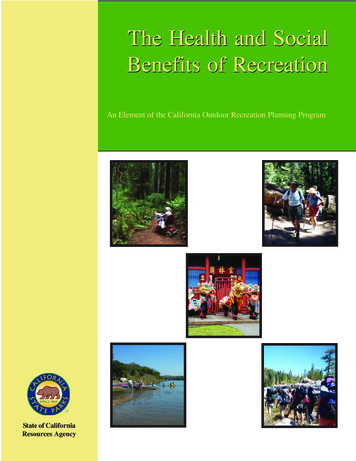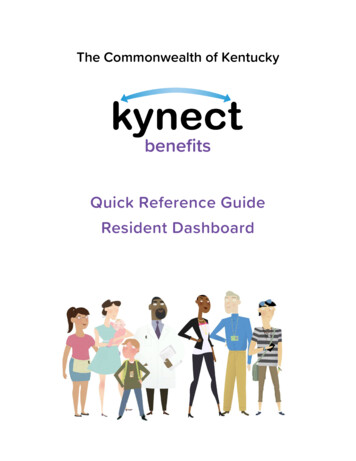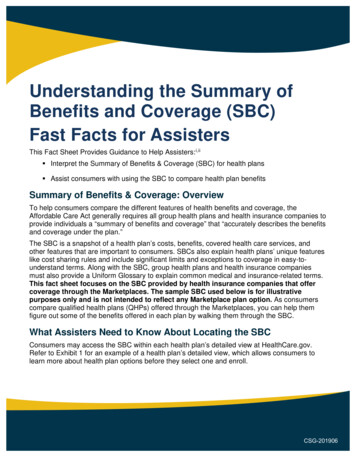
Transcription
The Health and SocialBenefits of RecreationAn Element of the California Outdoor Recreation Planning ProgramState of CaliforniaResources Agency
The preparation of this study was financed in part through a planning grant from the National Park Service,United States Department of the Interior, under the provisions of the Land and Water Conservation Act of1965 (Public Law 88-578, as amended).This report is an element of the California Outdoor Recreation Planning Program, formulated under the provisions of Chapter 5099 of the California Public Resources Code. 2005 by California State Parks. All rights reservedPrinted in Sacramento, California, March 2005.For more information or additional copies contact:California State ParksPlanning DivisionP.O. Box 942896Sacramento, CA 94296-0001(916) 653-9901, FAX (916) 653-4458www.parks.ca.gov/planningCalifornia State Parks does not discriminate against people with disabilities.To use the California Relay Service with TTY, call (888) 877-5378 or, without TTY, call (888) 877-5379.This publication is available in alternate formats by contacting the Planning Division at (916) 653-9901 orvisiting www.parks.ca.gov/planning.Printed on recycled paper.
The Healthand Social Benefitsof RecreationAn Element of the California Outdoor RecreationPlanning ProgramArnold SchwarzeneggerGovernorMike ChrismanSecretary for ResourcesRuth ColemanDirector, California State Parks
This page intentionally left blank.4The Health and Social Benefits of Recreation
The Health and Social Benefits of RecreationExecutive Summary . 7Introduction . 9Chapter 1: The Health Benefits of Recreation . 11The Physical Health Benefits . 11Reduces Obesity . 11Diminishes Risk of Chronic Disease . 13Heart Disease . 13Diabetes . 14Cancer . 15Osteoporosis . 16Boosts Immune System . 16Increases Life Expectancy . 17The Mental Health Benefits . 18Reduces Depression . 19Relieves Stress . 20Improves Quality of Life . 21Self-Esteem . 21Personal and Spiritual Growth . 21Life Satisfaction . 22Chapter 2: The Social Benefits of Recreation . 23Strengthens Communities . 23Reduces Crime . 23Encourages Volunteerism . 24Promotes Stewardship . 24Promotes Social Bonds . 25Unites Families . 25Builds Cultural Diversity and Harmony . 26Supports Individuals with Disabilities . 27Supports Seniors . 29Supports Youth . 30Develops Youth . 31Enhances Education . 31Deters Negative Behaviors . 33Decreases Drug and Alcohol Use and Early Sexual Activity . 33Crime Prevention . 34Conclusion . 36References . 395
This page intentionally left blank6The Health and Social Benefits of Recreation
Executive SummaryCalifornians today are confronted with a number of serious health and social issues - obesity, diabetes, depression and suicide to name a few. The trend towards a sedentary lifestyle is recognized as a major contributortowards many of California’s health and social issues. With the increased awareness of these issues, park andrecreation professionals, policy makers, health care providers, public safety officers and educators need tobetter understand the benefits that park and recreation lands, facilities and programs may play in addressingthese concerns. Healthcare and recreation professionals realize they must make physical activity fun, safe andaccessible to address these alarming health trends. They need to make recreation opportunities more availablewhile actively promoting the link between parks and recreation and better mental, physical and societal health.This publication documents the positive impacts that parks and recreation can have on the physical, mental andsocial health of individuals and their communities. The first chapter presents studies documenting the overallhealth benefits, both physical and mental. These studies demonstrate how physical activity helps to controlobesity, boost the immune system, diminish the risk of disease and increase life expectancy. Like improvementsto our physical well-being, many studies show that participation in recreational activities is an important contributor to Californians’ mental health and quality of life. California’s parks, trails and historical sites provideexcellent inducements to physical activity and our scenic views and waterways encourage active visitation. Asshown in these studies, parks and recreation can also aid in reducing depression, relieving stress, improvingself-esteem and personal growth.Chapter 2 includes studies outlining the social benefits of recreation, such as strengthening communities, promoting social bonds and supporting youth. Participating in recreation activities helps develop our youth, improve their education and deters them from negative behaviors. California is large and diverse and has a widerange of social conditions that influence the way we live, work, and recreate. These social conditions can beaddressed and improved through participation in park and recreation activities. Recreation opportunities andparks are essential for strengthening and maintaining a healthy community. Proximity to parks and recreationfacilities leads to safer, cleaner neighborhoods, volunteerism, stewardship and creates a livelier communityatmosphere.Social bonds are improved when families recreate together and when seniors and individuals with disabilitiesare actively engaged in recreation activities. Recreation and park facilities help promote social bonds by unitingfamilies, encouraging cultural sensitivity, and supporting seniors and individuals with disabilities. Recreationprovides us with family and community bonds that last a lifetime.Perhaps the most significant conclusion in this report is that these benefits can act in tandem. For example, arecreation program directed at youth obesity can increase self-esteem, reduce the use of alcohol, build familybonds, and promote volunteerism, all at the same time. The combined values that may be gained are almostendless. And, while not the subject of this study, clearly this has a positive economic impact and value to thecommunity as well. The aggregate impact of these health and social benefits makes parks and recreation one ofthe most cost-effective public services available to decision-makers.While additional research documenting the physical, mental and social benefits of parks and recreation isgreatly needed, the information compiled here is important for local and state park and recreation serviceproviders in gathering support for their programs. Educators, law enforcement personnel, and health providerswill also benefit from this information and should see park and recreation service providers as active partnersin support of their mission. Finally, local decision-makers must challenge their park and recreation serviceproviders to act on the individual and community benefits demonstrated in this study, and to provide them withproper support.7
This page intentionally left blank8The Health and Social Benefits of Recreation
IntroductionWhile parks and recreation can have a measurable impact on state and local economies, they can have important non-economic benefits as well. In this report benefits are considered advantageous changes, an improvedcondition or gain to an individual, group or to society. With our heightened awareness of the serious health andsocial issues confronting Californians today, it is important to better understand the health and social benefitsassociated with parks and recreation beyond their simple economic contributions.Some of the severe health problems that Californians currently face include obesity, diabetes, and cardiovasculardisease. Over two million Californians have been diagnosed with diabetes and cardiovascular disease. Theobesity epidemic alone is now costing the state over twobillion dollars each year. As noted in this report, a nationwide trend towards sedentary lifestyles has been identified as a major contributor towards these alarming healthtrends while also playing a part in such societal concernsas increased crime and juvenile delinquency.An estimated 7 in 10American adults are not regularlyactive during their leisure time and 4in 10 are not active at all(Schoenborn, 2002, April 7).To curb these disturbing trends, healthcare and recreation professionals realize they need to make physicalactivity fun, safe and accessible by making opportunities more readily available and actively promoting the linkbetween parks and recreation resources and improved mental, physical and societal health.While a number of recreation activities involve physical activity, the following four studies document a causallink between recreation facilities and physical activity: A positive correlation between environmental infrastructure (such as trails and recreation facilities andenjoyable scenery) and physical activity was found in a study of environmental determinants. The nationalstudy included 1,818 people, a majority of whom were low income (Brownson et al., 2001). Teens that used recreation centers were 75% more likely to engage in the highest category of moderate to vigorous physical activity, according to a long term study of over 17,000 teenagers. This nationalstudy provided the first evidence that community recreation facilities are important for adolescentactivity (Gordan-Larson, 2000). The annual Roper Starch Report found that 90% of Americans consider outdoor recreation as the bestway to be physically active. Even more felt that if people increased their outdoor recreation activities,the effects on their health would be beneficial (ARC, 2000). A large-scale Cleveland Metro parks study of older park visitors found that two-thirds of them werehighly or moderately active while in the parks. Three additional studies also document strong relationships between physical activity and outdoor recreation (Ho et al., 2003, April).This publication documents studies showing the positive impacts that parks and recreation can have on thephysical, mental and social health of individuals and their communities. This summary of pertinent studies buildson the ideas from two earlier publications, 1) the Driver et al. Benefits of Leisure (1991) and 2) The Benefitsof Parks and Recreation: a Catalog a Park and Recreation Federation of Ontario Canada publication9
(1992), which present and discuss similar earlier studies. This report summarizes and discusses a number ofadditional studies from 1990 forward, bringing in studies within California whenever possible.Percentage of Adults in California w ho reported no leisure-physical activity* by sex,race, and ethnicity, 2000M ale24.0%Fem ale29.0%W hite17.6%Black24.9%Asian/Pacific Islander30.4%Hispanic41.4%Total26.5%*No exercise, recreation, or physical activity (other than regular job duties) during theprevious m onth.Source: CDC, 2002The first section of this report presents studies documenting the overall health benefits, both physical andmental. The second section includes studies outlining the more social benefits of recreation for communities,social bonds and youth.This compilation of the documented health and social benefits of recreation is a product of the continuingoutdoor recreation planning program of the California Department of Parks and Recreation. This publication isan element of the California Outdoor Recreation Plan (CORP) and expands on the findings in its Benefits ofOutdoor Recreation chapter. This report will be made available to statewide park and recreation providerseither in hard copy or in electronic format on the California Department of Parks and Recreation’s PlanningDivision web page (www.parks.ca.gov/planning) and is intended to help them gather support for their programs.Although earlier editions of the California Outdoor Recreation Plan briefly discussed the values of outdoorrecreation in such general terms as reduced stress, improved physical fitness, and enhanced self esteem, thecurrent severe health issues confronting Californians today require a more explicit and detailed examination ofhow parks and recreation can help with these health and social problems. In a time of increasing health andsocial ills, it is critical to understand the many benefits of participating in recreation activities.10The Health and Social Benefits of Recreation
Chapter 1: The Health Benefits of RecreationThe first section of Chapter 1 describes the physical health benefits associated with recreation which specifically involve physical activity. Three separate studies document the positive impacts that physical activity canhave on obesity; dozens of studies connect physical activity to reduced risks for chronic diseases. Somestudies even demonstrate how physical activity can increase your life expectancy in measurable increments.Thesecond section addresses the mental health benefits derived from both active and inactive recreation opportunities. Numerous individual studies show how exercise, physical activity and even mentally recalling outdoorrecreation activities can have positive effects on depression, stress and self-esteem. Two-thirds of Californiansconsider outdoor recreation important to their quality of life.The Physical Health BenefitsCalifornia’s parks, trails and historical sites are excellent inducements to physical activity. These varied recreational opportunities make physical activity interesting, enjoyable, and encourage life-long fitness habits. Themany documented health benefits of staying active include reduced obesity, a diminished risk of disease, anenhanced immune system and most importantly, increased life expectancy.Reduces ObesityAs California’s sedentary problems grow, so does the obesity epidemic. Obesity continues to be a majorhealth concern and is closely linked to physical inactivity. Overweight and/or obesity is associated with increased risk for disease, mortality and chronic medical conditions, such as coronary heart disease, hypertension, diabetes, gallbladder disease, respiratory disease, some cancers, and arthritis.The Growthof Obesityin CaliforniaThe Growth of Obesityin California:“Percentageof California’s Population”2521.919.92019.218.717.316.0Percen 199219931994Years199719981999200020012002Source: CDC, 2002a11
Percentage of Children in Each Assembly DistrictWho Are Overweight178621114311613121518172021 224519232452897108611142715262512 13 16182021 2223241917212928273134303332403539454748P53acfi 15354725454 67 6869cea n54All California Assembly Districts becameeffective in the November 2002 electionbased on the 2000 67980777824.7%-26.5%26.6%-30.3%30.4%-36.8%Each range represents one-fifthof all Assembly Districts.Source: Koa et al., 2002
According to the Centers for Disease Control, almost 20% of Californians are obese, a figure directly affectingmortality rates and increasing health care costs (CDC, n.d.a). In 2001 the Surgeon General assessed the cost ofobesity in California at 14.2 billion in direct medical costs and lost productivity (Koa et al., 2002).The numbers of overweight and obese children and adolescents in the United States have doubled over thepast two decades. In California, over 26% of children are overweight and in some school districts the percentage climbs to 40-50%. Risk factors for heart disease (previously considered an adult disease), including highcholesterol and high blood pressure, are occurring with increasing frequency in overweight children and adolescents. The state chart, on the adjacent page, details the percentages of overweight youth in the differentassembly districts. Fifty percent of overweight adolescents will become overweight or obese adults; thispercentage increases if one or more parents are also overweight or obese (Koa et al., 2002).Exercising activities can help curb obesity. The correlation between recreation activity and health was highlighted nationally in a report from Health and Human Services, The Surgeon General’s Call to Action toPrevent and Decrease Overweight and Obesity 2001 (HHS, 2001). This report connects obesity to theneed for communities to provide adequate parks and recreation opportunities and recognizes the benefits ofincreased physical activity. The following studies highlight the benefits of physical activity in maintaining anappropriate body weight. Physical activity alone can reduce intra-abdominal visceral fat, which many scientists believe is the most dangerous kind, according to a controlled Seattle study of173 women (Hellmich, 2003).Active people are better protected against overweightand obese health risks, according to a review of 24current articles evaluating health outcomes associatedwith physical activity and body composition. Obeseindividuals who were active also had a lower incidenceof disease and mortality than did normal-weight men/women who were sedentary (Welk & Blair, 2000).The prevalence of obesity ismore strongly related to a lack ofphysical activity than to increases incaloric intake (Welk & Blair, 2000).Diminishes Risk of Chronic DiseaseRecreational activities also significantly reduce the risk of many serious diseases. The Physical Activity andHealth: A Report of the Surgeon General states that millions of Americans suffer from diseases that can beprevented or the symptoms improved through increased physical activity:* 13.5 million people have cardiovascular disease,* 1.5 million people suffer from a heart attack in a given year,* 50 million people have high blood pressure,* 8 million people have adult-onset (non-insulin-dependent) Type II diabetes,* 95,000 people are newly diagnosed with colon cancer each year, and* 250,000 people suffer from an osteoporosis related hip fracture each year (HHS, 1996).Heart DiseaseCardiovascular Disease (CVD) or heart disease is a leading causes of death. Three of the major factors thatsignificantly increase the risks of developing heart disease are 1) obesity, 2) diabetes and 3) lack of physical13
activity. Obesity and diabetes can be greatly reduced through regular aerobic exercise and physical activity.Recreation activities, such as running, brisk walking, swimming and bicycling are excellent for elevating theheart rate and lowering the incidence of heart disease, obesity and diabetes, if done regularly. Regular moderate activity, such as brisk walking for 30 to 60 minutes, reduces the incidence of cardiovascular disease according to a literature review of articles and studies published between 1991-2000 (Haennel& Lemire, 2002). Walking three or more hours per week cuts a woman’s risk of heart disease by 30 percent and five ormore hours cuts it by 40 percent, as found in a Boston New England Journal of Medicine study of over120,000 women (McCarthy, 2002). Modest physical activity changes the size and density of cholesterol-carrying proteins thereby causing lessdamage to the cardiovascular system. These benefits occur even if a person’s total cholesterol and weightremain the same (Associated Press, 2002). Exercise significantly reduces the chance for heart problems,according to 43 separate studies conducted by the Centers forDisease Control. Those who do not exercise are twice as likelyto have coronary heart disease (AHS, n.d.).More than 2,600 Americans die from CVD each day,an average of one death every33 seconds (AHA, 2002).DiabetesThere are over 2 million people in California with diabetes mellitus. Annually there are over 300,000 diabetesrelated hospitalizations with an estimated cost of 3.4 billion, ranking this disease as the seventh highest causeof death in California and the United States (CDCP, n.d.). Diabetes was once considered to be a middle-agedisease, but with the rise in childhood obesity, Type II diabetes cases are being diagnosed at every age. Theearly onset of Type II diabetes exposes people to the risk of infirmity, blindness, amputation, heart disease, andstroke at much earlier ages (Booth & Chakravarthy, 2002).Percentage of Californians Diagnosed with DiabetesSorted by age25Percentage20151 8 -3 43 5 -4 95 0 -6 465 10501990199119921993199419951996Y e a rs14199719981999200020012002Source: CDC, 2002aThe Health and Social Benefits of Recreation
The risk of Type II diabetes decreased progressively withincreasing levels of physical activity, as found in a longterm study of 5,159 men. (Wannamethee et al., 2000).The role of a sedentary lifestyle in the development of TypeII diabetes has been demonstrated in longitudinal studiesof college alumni, registered nurses, physicians, and middleaged British men (Kriska, 1997).Physical activity alongwith a balanced diet appears tobe the best combination for decreasing weight and improvingglucose tolerance and insulinsensitivity (Kriska, 1997).CancerCancer, along with heart disease is another leading cause of death in the United States. In 2003, the AmericanCancer Society estimated that there were 52,200 deaths and 125,000 new cases of cancer in California.People who exercise have a lower incidence of colon cancer than their sedentary counterparts, according to 25out of 33 publications on the relationship between physical activity and colon cancer (Lee, 1995). Active living hasbeen shown to help prevent site-specific cancers, particularly in the colon, breast and lungs.Cancer Deaths by Race/EthnicityCalifornia 2000(N 53,005)Black 7.40%Asian/Other 7.80%Hispanic 10.90%White 73.90%Source: CDHS, 2002 It was found that those who were more physically active in adulthood had a lower risk of breast cancerthan those who were less physically active. Consistency of activity was more important than intensity in astudy which followed 121,701 nurses (aged 30-55) from 1976-1992. These nurses were surveyed atdifferent points during the study period to gather data on physical activity, such as the average number ofhours per week spent participating in moderate or vigorous “recreational physical activity” (walking, jogging, cycling, swimming, aerobic dance, tennis, etc.), (Rockhill et al., 1999). Increased leisure-time activity was associated with a reduced risk of breast cancer in a study of 25,624women who either exercised regularly or were sedentary. In those that exercised regularly, the reduction inrisk was greater in pre-menopausal women than in postmenopausal women, and greater in younger womenthan in older women (Thune et al., 1997).Physical activity must be sustained over time to protect against coloncancer as demonstrated by a study thatfollowed more than 17,000 men for almost26 years (Lee, 1995).15
A study found that women who did not spend any time being physically active had 2.4 times the risk ofbreast cancer than did those who exercised 3.8 hours or more per week. This 1994 study was of 545women, 40 years or younger, with breast cancer and compared their physical activity patterns to 545similar women without breast cancer who were the same age, race and from the same neighborhood (Lee,1995).OsteoporosisStrong muscles, joints and bones can be maintained by physical activity that adds additional stress to strengthenthe skeletal structure. Weight-bearing activity is essential for normal skeletal development during childhoodand adolescence. Regular exercise, especially muscle strengthening, may protect against the rapid decline ofbone mass in post-menopausal women and protect the elderly from falls and fractures by increasing theirstrength and balance. The benefits of physical activity on various types of arthritis are uncertain, althoughincreased muscle strength, bone density, and connective tissue could provide some relief for arthritis symptoms. Many reports have shown that bone mass in physically active individuals is significantly higher than intheir inactive counterparts. Sports that use one side of the body, such as tennis, best demonstrate how exercisecan have positive effects on bone density (Shaw & Snow, 1995). Participating regularly in other recreationactivities such as hiking, kayaking, weight lifting, and sports help maintain bone and joint health. Women, who exercised regularly in their 20’s and had a healthy intake of calcium, decreased by 30% theirrisk of developing osteoporosis in their 70’s (Gorman, 2002, Jan. 21). Physical activity after menopause can enhance an estrogen replacement program for decreasing bone loss(Shaw & Snow, 1995). Participation in organized fitness and sports programs helps children build higher bone density, combatingosteoporosis in later life (Shaw & Snow, 1995). Regular physical activity increases bone mass, bone and muscle strength, and improves the structure andfunction of connective tissues (Paffenbarger, et. al., 1991).Boosts Immune SystemThe physically fit person is less prone to illness. A Centers for Disease Control & Prevention study found thatphysically active individuals have lower annual direct medical costs than inactive people. Active individuals hadfewer hospital stays, fewer physician visits and used less medication. The savings were consistent for men,women and even smokers. These savings are demonstrated in the adjacent charts. If all adults achieved verymodest levels of physical activity, the estimated nation-wide savings would be 76.6 billion annually (ARC,2000).16 People who exercised for 20 minutes once a week were significantly less likely to call in sick than nonexercisers. Those who exercised twice a week missed even less work according to an Oklahoma StateUniversity study that tracked 79,000 people for a year (Mooney et al., 2002). There was a 23% reduced risk of upper respiratory tract infections for people who were regularly active compared to those who were not, according to a study of 547 adults (Nieman, 2001).“.local park and recreation usersreport fewer visits to a physician for purposes other than checkups than did non parkusers.” (Ho et al., 2003, April).The Health and Social Benefits of Recreation
Research shows that positive changes in the immune system occurs during moderate exercise. Even thoughthe immune system returns to its pre-exercise condition, each exercise session appears to be additive inreducing the risk of infection over time (Nieman, 2001). By participating in community activities and surrounding themselves with family and friends, social peopleare four times less likely to get colds than those whoare more isolated (O’Sullivan, 2001). Increases in positive moods, which have been linkedto enhanced immune response, are reported followingparticipation in and recollecting about outdoor recreation activity (Tarrant et al., 1994).Increases Life ExpectancyReg
health benefits, both physical and mental. These studies demonstrate how physical activity helps to control obesity, boost the immune system, diminish the risk of disease and increase life expectancy. Like improvements to our physical well-being, many studies show that part











